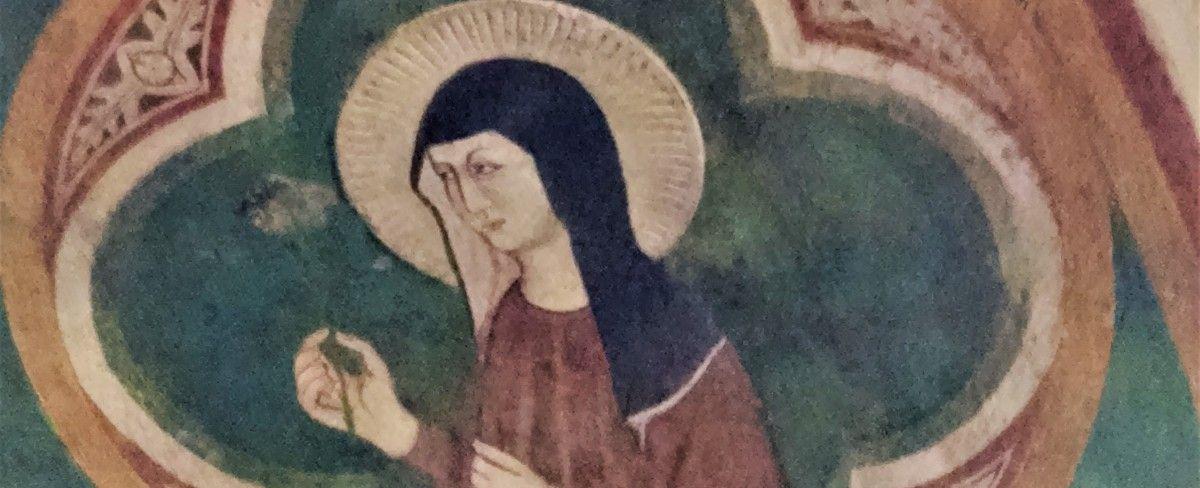Saint Clare: Light of Assisi

In 1253, Clare’s health began to deteriorate. With August’s scorching temperatures, she was closer and closer to the end. As always, the late summer heat drove the papal entourage from Rome to the refreshing heights of Perugia. It would not be long until these dignitaries heard the news echoing from hill to hill in the Valley of Spoleto: Madonna Chiara was dying.

A fresco of Clare and her sisters can be found at San Damiano near the dormitory. Photo by Greg Friedman, OFM.
Pope Innocent IV understood the meaning of the moment. His nephew, Cardinal Rainaldo, accompanied him on the journey to the little cloister. This pope, whose attempt at a Rule for the women had been politely rejected by San Damiano’s sisters, arrived to see its famous abbess. She received him with utter respect and humble gratitude.
How wonderful was this? The successor of St. Peter was under her roof! He asked the crucial question: What was her deathbed wish? She was ready with her answer. Would he place his signature and seal on her Rule? No question would ever be raised about its force and power if he were to comply with this one wish. Her plea was uttered with all the force of a soul bent on completing its earthly mission.
What followed was a touching 24-hour drama. Cardinal Rainaldo gave his approval by signing the actual parchment upon which the text was inscribed. Normal protocol would have required that a new manuscript be prepared in the pope’s secretariat. However, it was clear that there was not enough time if the pope was to grant her wish before her final hour. His choice was to expedite the legal process.
Using the manuscript already signed by Cardinal Rainaldo, he added his own signature and date. To this was added his impressive seal. As he ordered it to be sent back to Assisi, he may have reflected that it would serve one monastery and one monastery only. No great harm done, therefore, in acceding to the dying wish of a respected abbess. Besides, it was a work of mercy that might win heavenly favor for him in an hour of need. Assisi’s newest saint would surely intercede for him after death.
A friar-messenger was dispatched to bring it back to Assisi with all possible speed. When the document was placed in her hands, Clare took hold of the beautiful papal seal, affixed with golden cords and hanging from the scroll. Later, an eyewitness would write on that parchment, “Blessed Clare touched and kissed this many times out of devotion.”
This elation expressed her utter relief and joy. She had succeeded in creating a perpetual witness to the first inspirations of the Poor Sisters and their covenant with Francis and his Lesser Brothers. Like her Divine Master, she could now say, “It is finished.”
Visions of the Vigil
The extraordinary papal about-face that took place in those August days was not the only miraculous event witnessed by the women keeping vigil with Clare in her final days. Those who were present would later recall other dramatic signs that they sealed in memory.

This detail from the sculptured doors of the Church at the Sanctuary at Greccio shows Clare, supported by her sisters, perhaps as she was dying. Photo by Greg Friedman, OFM.
A nun in the Monastery of San Paolo shared an exceptional vision. In it she and her sisters were at the side of Clare, who lay in a beautiful bed. They grieved with the distraught sisters keeping vigil. Then a woman of great beauty appeared at the head of the bed and assured the sisters that Clare’s victory was assured and that she would not die without seeing “the Lord and his disciples.” The fact that nuns of San Paolo had such vivid experiences of Clare’s final days hints at a relationship that had blossomed over the years since her Eastertide sojourn in 1212.
Sister Benvenuta of Lady Diambra and Sister Anastasia heard Clare speaking softly at one point but to no one in particular. Worried that Clare was trying to express a need or discomfort, they asked to whom she was speaking. The answer was, “I am speaking to my soul.” Later, the words they heard were recorded. Clare was, in fact, expressing the kind of hope that replaces fear with her trust in God to escort her over death’s threshold as a mother guides a frightened child. Sister Filippa reported that Clare made a final confession and she marveled at what was told by the dying saint.
Three days before Clare’s passing, Sister Benvenuta began to imagine the way Clare would be received in heaven at the point of death. The imagining morphed into a visionary experience in which she saw a group of women—dressed in white and wearing crowns—surround the bed. In the middle was one woman whose crown was larger and more ornate. The description implies that it was Mary, queen of heaven. The women brought a delicate, transparent coverlet to spread over Clare, a gesture reminiscent of women preparing a bridal bed.
In the dormitory of San Damiano is a bronze bas-relief on the wall of the room where Clare died. It shows friars who are clearly bereft kneeling at her side. Her biographer tells us that Brother Angelo was mourning and supporting the grieving sisters while Brother Leo “kissed the bed of the dying woman.” The placement of the sculpture is a reminder of the strength of that promise of care and solicitude that Francis made to Clare.

Clare and her sisters lived at San Damiano in Assisi. Photo by Dominic Monti, OFM.
His oldest friends carried that promise with them as they shared the transitus of their sister. Did they, in the long hours, recall the time when Francis himself set about repairing the crumbling structure of the place? It was his first project as a newly recognized penitent, and he was offering his physical labor to the local priest.
Margaret Carney, OSF
President Emerita of St. Bonaventure University
Margaret Carney, OSF, is a member of the Sisters of St. Francis of the Neumann Communities and is a teacher of Franciscan history and spirituality. She continues to serve as a lecturer and leader for Catholic higher education and Franciscan organizations in the United States. She is president emerita of St. Bonaventure University.

